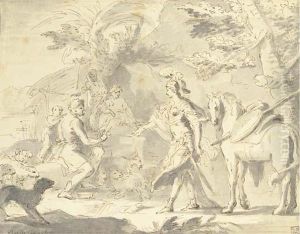Placido Campolo Paintings
Placido Campolo was an 18th-century Italian painter associated with the late-Baroque and early-Neoclassical periods. Born in 1736 in Reggio Calabria, he grew up in a time when the Rococo style, characterized by its lightness, elegance, and use of curvilinear forms, was still popular. However, the latter part of his career coincided with the emergence of Neoclassicism, which looked back to the art and culture of ancient Greece and Rome for inspiration and emphasized clarity, order, and restraint.
Campolo's work reflects the transition between these two styles. He was known for his frescoes, altarpieces, and religious works, which often combined the dynamic movement and dramatic contrasts of the Baroque with the emerging classical sensibilities of Neoclassicism. Although not as widely known as some of his contemporaries, such as Canova or David, Campolo contributed to the artistic landscape of his time, particularly in southern Italy.
He is most notable for his work in churches in his native Calabria and the surrounding regions. His frescoes often depicted scenes from the Bible or the lives of saints, rendered with a sense of drama that was characteristic of Baroque religious art. Despite his talent, Campolo did not gain the same level of fame as some of his peers who worked in more prominent Italian art centers like Rome, Florence, or Venice.
Placido Campolo's career was relatively short as he died prematurely in 1789, at the age of 53. His art remains an important representation of the stylistic transitions taking place in Italy during the latter half of the 18th century. Unfortunately, due to the geographical limitations of his work and the overshadowing fame of other artists from the period, comprehensive studies on Campolo's life and work are limited, and his name is not as recognizable in the broader narrative of European art history.
